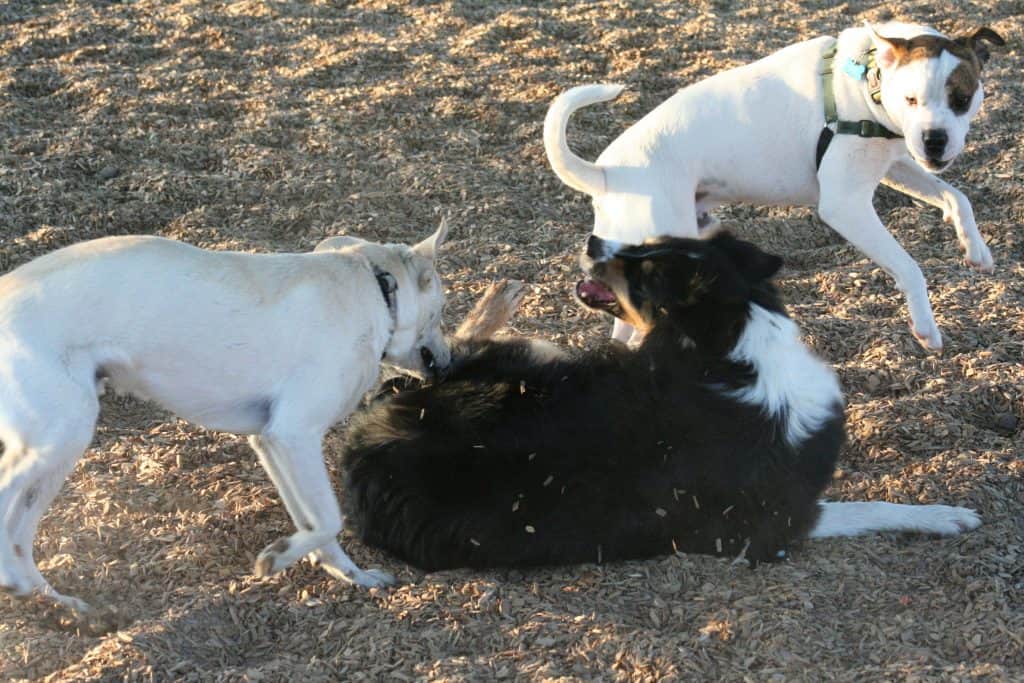
- Watch what’s happening before you enter, especially with a new dog park. Sometimes you may not want to enter.
- Unleash your dog in the entry area. A dog on a leash cannot move away if scared. If this causes a fight, you may be the one at fault.
- Don’t stay too long right outside the fence. Dogs will not calm down but become more anxious. If you really need to calm them down, move a distance away.
- If there’s a mob at the gate and your dog is new or scared then ask for help before you enter, or move back and wait for some of the dogs to leave the gate area.
- Stop phone texting and watch your dog.
- When picking up your dog’s poop, grab any other nearby. The bag has room & you’re all walking on the same ground.
- If your dog is initially very wild, see if a brief walk or other activity will calm him down a bit.
- If you’re unsure how well any dog is behaving, start by looking at the other dog to see if he’s concerned before you jump up.
- A dog on his back can be submissive, or simply play that he enjoys, even with a crowd over him.
- Leave the treats at home.
- Many small dogs are fine with larger ones, but if unsure about your dog, start in the small dog area or ask somebody to bring their dog into the small area for yours to meet without getting overwhelmed.
- If your kids want to run and play, send them to the park instead.
- Try to identify and befriend the regulars. Both for advice, and for support if an idiot walks in.
- No simple set of points is enough, and many others can be misleading if you’re not familiar with dog behavior. You can’t stop your dog from being a bully if you don’t know what a dog bully is.
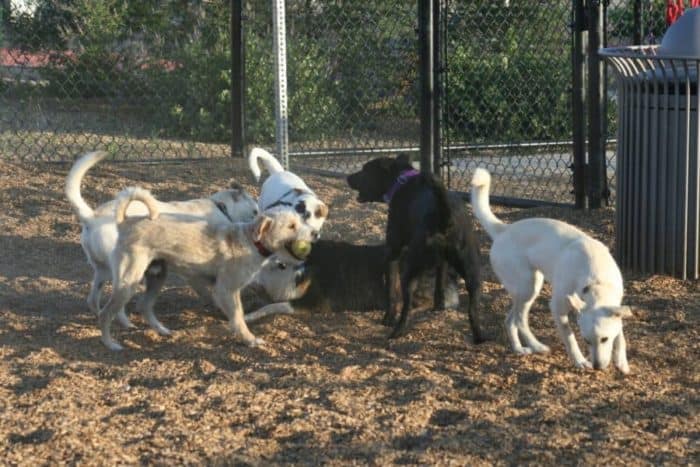
Table of Contents
Why go to a Dog Park?
Dogs are generally social animals who enjoy the company of others. While some may simply enjoy hanging around and watching, take a look at the small mob that usually gathers at the gate when a new dog arrives. While dog walks provide some exercise and the chance to look around and see a bit of the world, the running and playing at a dog park provides much more, especially for young or playful dogs.
Even if they live with other dogs at home, there are still the skills and joy of meeting many others. Some dogs live just fine with others they know, but may not yet have the skills to quickly meet others. And there are a few who will walk around and sniff, then just settle back and watch the activity, like people enjoying a sports show or soap opera.
In many neighborhood blogs people write in about how their dog panicked while they were walking them and another dog passed by or a loose dog ran up. Many who frequent dog parks are far quieter when passing other dogs, and no longer panic when approached.
But, what about all the Dog Park Issues I’ve Heard About?
So, you’ve heard about or had a dog park incident, or just got a little scared. And now you would never, ever go back to a dog park and advise others to do the same. I see this repeated all the time in many internet blogs.
For each such incident, there are thousands of visits with no incidents. For each one of those, there are thousands of barking dogs locked up behind their houses who bark because they’re bored and rarely get any more than an occasional walk. Some people never take them to Petsmart or elsewhere because of all the diseases that can be passed around. Really? Either ask your vet or google to see just how often that really happens. Probably far more often with people than dogs, so maybe send your dog out and you just stay home?
And remember, all the news reports focus on sensationalism. Real and balanced journalism would give you some perspective, telling you just how often or rare these occurrences are, but that’s not what we see. And even many vets and dog trainers only see and hear about the issues, and have no idea of the frequency.
The Breeds and the People
One person wrote that you never know what mood a dog is in or what kind of dog you may encounter at a dog park. Perhaps they’re looking at the wrong things, as I look more at the people. Recently, a new adoption came to the dog park for the first time. They mentioned this before entering, and people grabbed the more rowdy dogs for a minute. Everybody watched the new dog come in and how all the others acted. In a few minutes he was settled and playing. Then a senior toy breed came in and they slowed down the crowd until he settled in and could calmly walk around and sniff.
What about Pits? We may have more of them there than any other breed. I’ve got two of them right now, and work with hundreds of other pits. Yes, I do see some breed issues. Such as most Danes are goofy, Mastiffs are calm, gentle, and tolerant. And Rotties get chased by scared Chi’s, and many Bassets are pretty loud. Far more than breed, it’s the dog’s personality combined with the owner’s guidance that makes the difference.
In the past few years I’ve taken several dozen foster dogs to the dog park. While they’re fine living with a few others here, it’s important for them to learn how to meet new dogs and be confident enough to handle situations without getting scared enough to start a fight. Many of them come here very scared and unsocialized, and their chances for adoption are very poor. Many potential adopters already have a dog, so they need the skills in meeting them.
I had a very new and young pit foster who was scared of meeting new dogs. It was a week or so before she could meet the general group at the dog park even though she plays with others at home. Then she was introduced to selected dogs at the dog park. First, a Mastiff got her calmed down and playing. Then a Chow Chow, then a playful Cattle Dog slowly tried to bring her around. The point is that many dogs will not learn overnight, and need some time and guidance. With daily exposure, most of my fosters learned in only a few weeks, much faster than many people we know.
Yes, we have our share of cell phone texting people who try to just ignore their dogs, but hopefully not too many of them. I’ve scouted and asked about some other dog parks, and some I won’t go to. Not from the dogs, but the people. I advise new dog park visitors to first spend a few minutes watching both the dogs and the people, and you’ll quickly see if they’re watching and managing the dog play. You may notice which are the regulars, who know many of the dogs and are usually very willing to help a new dog (and new person) get situated.
Find the Regulars!
If you start going to a dog park, make an effort to meet those regulars. People will often help each other, and it’s useful to have some friends when the occasional problem (person, not dog) comes in. This is especially helpful if your dog may have issues and you are not familiar with dog behavior. Many people don’t know how to tell the difference between normal dog play and bad dog manners, or a fight about to start.
On one trip to the dog park, I found several of the regulars had moved to the small dog area. In the large area was a woman whose dog had very poor manners and, while her dog caused fights, the woman insisted that that was how dogs play and the others should learn or leave, so they left. Another woman then came in and her small dog was attacked. She tried to break it up, the first woman yelled and lunged at her, and shortly after the police arrived. Fortunately rare, but it happens.
Overall, keep your perspective here, as people like reading and commenting on bad stories. I took four dogs to the dog park today and they all had a lot of fun, dropping down for naps when we returned. I’m retired and at the dog park hundreds of times each year with very few incidents. I’ve run hundreds of shelter play groups, with very few serious incidents. But, you won’t see those stories in the news.
Muzzles
Now, are muzzles so bad? No, they can be useful during training, but are not a permanent solution. A dog with a muzzle being first introduced to a dog park is putting that dog under a great deal of stress. I’ve seen people try this even without first getting the dog used to wearing a muzzle. Most dogs who may need muzzles are due to fear aggression, and the muzzle itself doesn’t cure that, but you can learn how to help them. But only if you do so! Instead of a dog park with a muzzle, you can arrange for some play dates instead.
What Did That Mean When the Dog Did That?
When in doubt, always look at the dogs, and what they do after any incident. Always! If the dogs are fine with it, then stay out of it. Dogs learn by trying things, and not all things they try will turn out.
So what does it take to understand dog body language? The first step is to realize there are degrees. You will pick up a few items from a short article, but much more knowledge and experience is needed to become really proficient. You’ll hear many people try to guess what might be in a dog’s mind, but while that may be fascinating, it’s of limited use. Far more important is the ability to predict and modify their behavior. If your dog becomes nervous when other dogs approach you, is he protecting you? Or does he simply see you as a close companion who provides security and he’s afraid of anything that may prevent that? While the latter is far more likely, you should focus instead on your actions that make him feel more relaxed and better behaved, and less on conjecture.
A new dog, small and young, was at the dog park. My dog walked over to sniff, and she growled at him, at which he simply stopped and turned slightly to the side, and waited. The people began to yell at their dog for being nasty, and I explained to them that their dog is simply saying that she’s nervous, and to watch what my dog is doing in response. That if they leave it alone their dog will slowly approach when she’s ready, but if you stop her from saying she’s scared, she will either have to run away or attack any dog who comes close. Again, always watch the other dog’s response.
Barking, and barking
You may have people getting upset with one dog barking, but if all the other dogs don’t care, this is only a “people” thing and the only reason to intercede is if you want to teach your dog to be quieter for people. Other times you may see other dogs upset, or avoiding your dog because of his continued barking. Your interpretation should follow how the other dogs are responding.
If dogs are in both (small dog and regular) areas, you may sometimes see some fence running with wild barking and running. Most times this is just play. You may see dogs on one side loud and looking ferocious, just trying to convince the other dog to start running. In general, if dogs on both sides are doing this and not moving, that’s closer to aggression and it’s time to break it up. Another issue is with several dogs together, where one becomes excited enough to redirect on a dog next to him, which can also cause a fight. The dogs know that the fence is there and that they can safely look absolutely terrible with little risk of causing damage. Just like any other activity, however, too much intensity can cause issues.
Entering the dog park
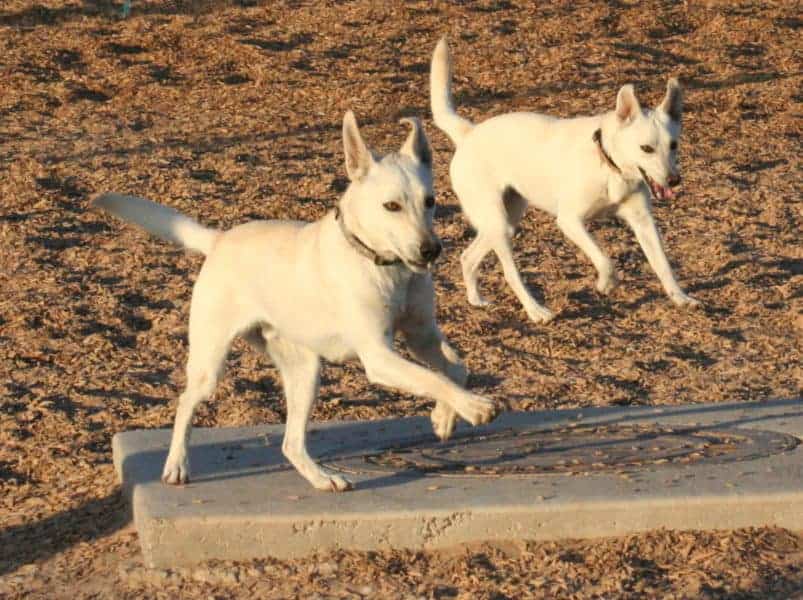
You should unleash your dog before bringing them through the 2nd gate. The biggest crunch is usually at the gate when a new dog first comes in. If you have your dog on a leash restraint then he can not back away from other dogs in his face. If he gets scared, your dog may have no choice but aggression, and that may be your fault, and not his.
On your first visit, look to see how scared or reactive your dog seems. If he has not met new dogs before, then you may want to come at a time when only a few, calmer dogs are there. Alternately, if a small dog section is empty, you might ask somebody there for a social dog to bring in with your dog, to give him (and you) time to adjust.
Dogs will rarely adjust by looking through the fence, with some becoming more anxious and reactive. Only when the dog can freely move around the others will he start to settle in. It is the interaction he needs to promote learning, not how to watch from a distance. So if he appears anxious, do not just try to hold him at the gate until he calms down. Move him back to calm him down, then enter quickly.
And start teaching your dog “come” or “back” and start using this every time a new dog comes in, so that your guy’s not part of that mob. That also makes it much easier for the people to enter.
And, CLOSE THE GATES! Don’t count on the gate closing by itself, and don’t ever allow both gates to be open at the same time. There’s always the chance that the dog you didn’t see can run out.
Should he exercise first?
Many active and friendly dogs will run into the dog park at full speed, wild and sometimes ill-mannered for the first few minutes, then settle down. Some of that is tolerable, but some others just get too excited and it’s far better to take a short walk or some other activity before entering.
Cell Phones & Conversations
Don’t forget your dog may need your support, or others if your dog misbehaves. It’s not hard to have a conversation while still watching your dog, but texting on a phone is something else.
Pick Up After your Dog
So often said, but the only solution seems to be having each person pick up 2-3 poops every time their dog goes. Unless you have a Dane, the bags are easily big enough for the pile next to the one your dog left.
Wild chases and dog piles
You may see five dogs chasing a running dog, who then stops, rolls and they all pile on her. A natural human impression is they are picking on that dog. But, more often, the dog at the bottom has prompted the chase and pile up, and is controlling it. Hearing a group of people worried, I pointed this out and showed that as soon as the bottom dog signaled (holding still), all the dogs stopped moving. She caught her breath then ran out and another chase began. Some dogs are Cheerleaders who do this all the time.
But no rule is absolute. Some Cheerleaders are just learning or find they cannot handle some dogs, who get so excited they stop responding to their signals. That’s when they may need your help.
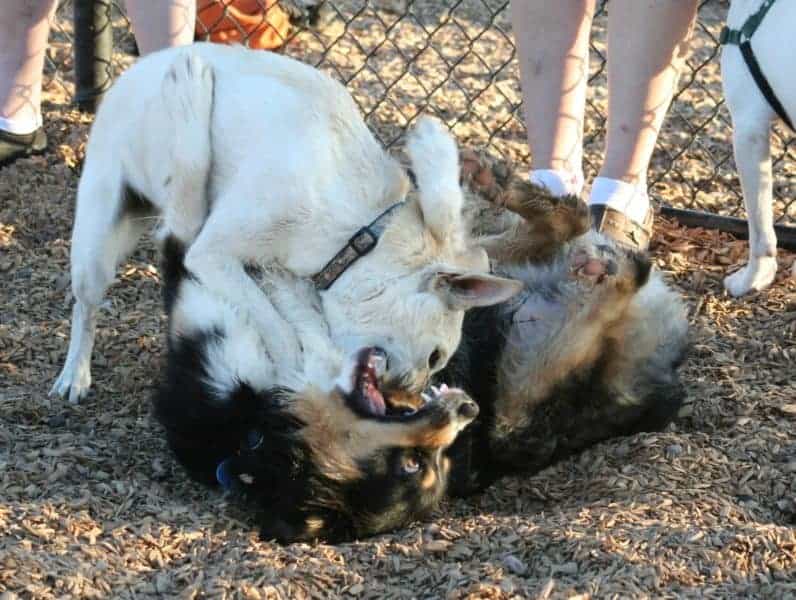
Signals and Corrections
Dogs use a deference system to avoid costly fights. This involves a set of signals and corrections which are not aggression, but may appear so to some people. In avoiding contact, the first signal is often a dog freezing in place, with his body at right angles to the other dog and his head turned away. That means do not approach, or please move away. Some dogs may take a brief sniff or briefly lick his lips then move away. If they continue lip licking, he may correct them. Younger dogs will often do more lip licking (a calming and deference gesture), and will typically be more tolerated than older dogs.
Next, the dog may tilt his head, draw back his lips showing a little tooth, and give a low growl.
Or, with a simple correction, the dog may give a bark or growl as he snaps at the air in the direction of the other dog, then immediately turns his face away with his body at a right angle, indicating he does not want to continue.
One level up from this, he may lunge at the other dog, sometimes pulling out some fur, then stopping and turning his head away.
Not all dogs use all levels or do them in exactly this manner, but most are pretty close. All of this is called agonistic behavior to try and avoid actual aggression.
Some dogs who are afraid or lack social skills may escalate this too quickly or correct too sharply. Some dogs who are corrected become afraid and move aggressively forward instead of backing away.
Either case may result in a fight, and all of this may happen in just a few seconds.
Looking back again at the dog who flops on her back, a playful dog will wiggle and reach out to the others. For submission or calming they will stay fairly still and tend to ignore the other dogs, waiting until they move away.
Dog body language
Everybody likes to look at the tails. But tails are very variable and need to be calibrated for each dog. The rest of their body language is more important, and especially any action the dog subsequently takes. Sometimes the dog may show conflicted body language, and it’s only their subsequent action that tells you what it really means. While guides on body language are useful, always check what happens after to see if you were right. I saw one guide on dog tails that tried to show about five different positions and movements and give them each a meaning. They were probably wrong at least half the time.
On tails, watch the dog a while, observing how his tail behaves in different situations, and what the dog subsequently does. Then you can use that to figure out the meanings.
Large and Small Dogs
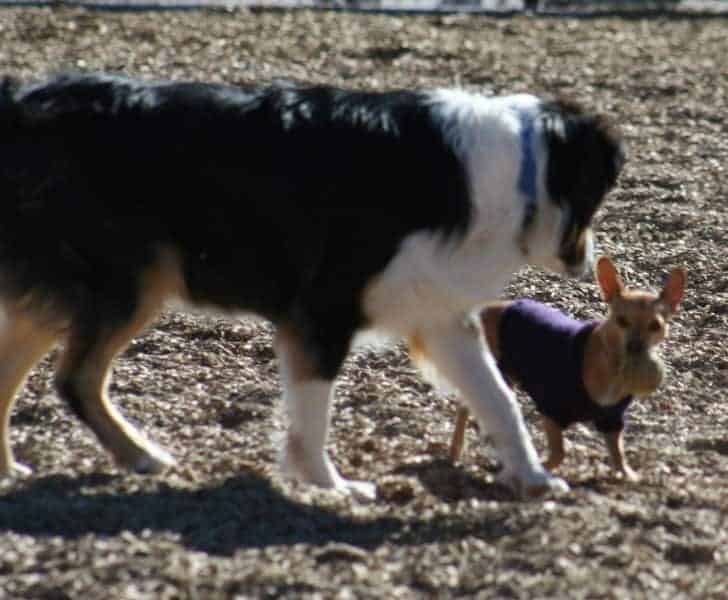
Should they always be separate, or allowed to mix? Several issues come into this. First, there are some delicate breeds like Italian Greyhounds that can easily be hurt from normal play by larger dogs. Then you have small dogs who are scared and come out with a high-pitched fear whine. While most Mastiffs and Rotties may deal well with this, you may see a crowd of Cattle Dogs and Pits running over at full speed. While a few may show prey (actually, more chase than prey) aggression, more often the excitement just proves too much and they forget their manners. Either case can hurt the smaller dog.
Until and unless they adjust, those dogs need to be brought in either with some calm Labs or in the small dog areas.
But, there are Chi’s, MinPin’s and others who can come in and chase Danes around. One Chi used to run with three larger dogs playing, and when things got rough he’d run right under a big GSD for some shelter. I see more small dogs coming in the main area than the small dog area.
Dogs Learning to Meet Dogs
It takes time, and if you give them the time and guidance, they will generally learn faster than we did as kids. Remember, living with other dogs is not the same as meeting new ones. Consider, you may grow up in a house with several people, but the first time you walk into a new job where dozens of new people may be staring at you it can be rather intimidating.
So expect a new and scared dog to slightly overextend himself with another dog, then run away after a single bark & snap or with a squeal. Well-mannered dogs will then back away from him for a few minutes, to allow him to recover. If not, he may need your help. Don’t try to avoid your dog doing this or he won’t get the chance to learn, but make sure he does get his recovery time, which may be a minute, or only a few seconds. He may then do this dozens of times the first few visits, but you’ll soon see that changing, with longer play and shorter recovery times.
Especially for the first few visits with a nervous dog, watch carefully and prevent them from being trapped in a corner or a mob of dogs where they can’t easily move away. They may need your help here!
He may need to try different things, to see what he likes and what works well. Watch that he doesn’t let himself become too anxious and that he moves away when he needs some time, or pull him back for some reassurance then let him try again when he’s calmed down and ready. If he becomes scared and stands there, or advances on the other dog, there can be an issue, but also look at the other dog. If yours just freezes in place and waits, and the other dog shortly after just walks away, that’s common and normal.
But My Dog Doesn’t Play!
It may take a half-dozen visits or more before he becomes comfortable enough and learns play skills. Some dogs may become fairly selective, learning which types they enjoy and only playing with them. After living with your dog for awhile, you’ll gather a good sense of when he’s comfortable. Some dogs get excited about the dog park, but others simply enjoy being there and watching.
Kids in the Dog Park
A dog park is not the place for your small kids to learn about dogs. Go see your neighbor’s dogs instead. There may be dogs at the park who do not know how to behave with kids, so don’t bring in kids who will scream, wave their hands and run when a dog comes over and doesn’t do what they expected. Going further, some scared dogs may panic when a kid walks over to them and ignores their fear. If a kid runs or plays, a dog who doesn’t know kids may try to play with him, like he would with another dog, including some jumping and nipping. Finally, imagine an 80 pound dog running in play, accidentally colliding with a 30 pound kid who’s just walking around there. This is a dog park.
No, I don’t care if your kid currently lives with three dogs at home. He is not at home. Nor do I care if there are only small dogs inside right now, as others may come at any time.
If anything happens between a dog and a kid, it can quickly become serious. The dog may be quarantined or killed and the child badly injured, all due to your neglect. Remember these six points:
- Some dogs do not live with children, and don’t know how to behave with them in a play area.
- Some dogs are shy and fearful, being scared when a child just keeps walking to them.
- Some are recent adoptions, where they’re good with adults, just learning to meet new dogs, and know nothing of kids.
- A playful and running 60-pound dog can easily knock down a young child.
- While many dogs are fine with well behaved kids, at any time a scared or inexperienced dog may enter.
- Brief dog fights will happen, but can be difficult to manage with young kids present.
Let the Dogs work it out, maybe…
Sometimes you let your kids work out issues with other kids, but other times you need to intercede. That’s no different with dogs, as they will not always work out all things on their own, and you should try to learn how to tell the difference. Very often there will be a few other people there with much more experience who can help you.
I’ve seen one scared dog overly correcting others who approached her (then stopping). Every dog there understood and simply moved away. Some came back to gently prompt her to try and get her to relax, then moved away. But, her owner corrected her for doing this, saying she was following the directions of a very experienced dog trainer. So she increased the dog’s anxiety instead of reducing it, and while the dog did slightly improve, this took many months for what could have been done in weeks.
Dogs Mounting
Sooner or later, it’s going to happen. All of my foster dogs are taught how to handle it, in the best way for them. Some may ignore it for a while, while others may roll or run out of it. New fosters may be nervous at first, but many will listen to prompting and they adjust.
It’s usually people who are far more concerned. Many call it dominance, while others call it sexual. But first, you need to realize that most early play activities for dogs are based on the later need for predation or sexual congress. The chasing, pouncing, grabbing and rolling we start to see in puppies are all practice for catching prey later on. Yes, a dog going above another dog (head, body, or butt) can have a component of social ranking or a sexual overtone. But, play is usually the predominant reason.
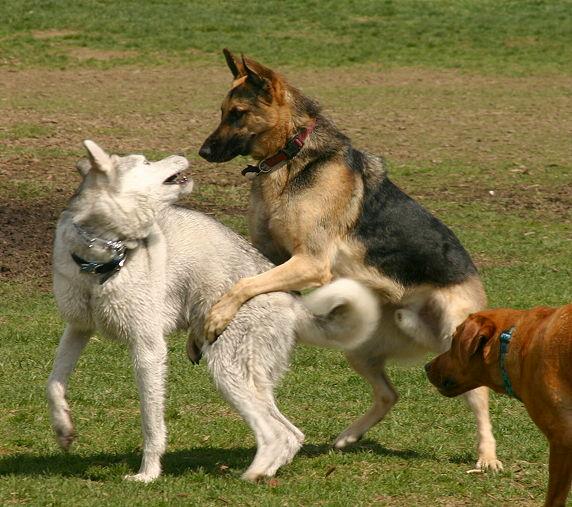
If the other dog appears in distress, it has continued overly long, or he’s locking his legs so the other dog cannot get free, then I’ll stop it. Otherwise, and most of the time, the dogs will handle it. The most common reason for stopping this is that people get upset.
For a further discussion, see Theories of Mounting and Psychology Today: Why Dogs Hump
He said: “Don’t touch my dog!”
One dog came in and immediately ran after a frisbee his owner tossed. I knew this guy takes a few minutes to calm down, but until then he guards the frisbee. A few other dogs came over when he brought it back and a fight was about to start. As I was there, I simply waved my hand in front of him to break his visual lock and called his name, just enough to calm things down. His owner then started yelling at me for touching his dog, and didn’t stop until other people came over to tell him it was his issue with his dog and he should have been there, that his dog had been starting fights with other dogs, and besides which I never touched him. Five minutes later, his dog was then fine. He apparently thought about this later on, as the next time I saw them he was both friendly and attentive.
But my Dog Trainer Said So!
Two women were trying to teach their dogs to behave well with others. So they brought in four dogs on leash. They called other dogs to sniff them, forcing their dogs to hold still. Several fights nearly started, as their restrained dogs could not move away when scared. If their dog didn’t behave, he was slapped in the face and forced into an Alpha Roll.
An approach like that is inefficient, abusive and dangerous. Proving only that some dog trainers can also give poor advice. After a few minutes, nearly everybody else simply left the park.
Treats in Dog Parks?
Some parks forbid this, for good reason. But it can work if you know all the dogs, there are not too many dogs, and the owners give permission. They will know if their dog has allergies or becomes aggressive with food and other dogs around. Of course you never throw the food, but give each dog separately. Bear in mind that some will remember where you got the treats from, and you may become a little too popular for awhile.
But unless the situation meets all of the above, don’t bring in treats. Remember, if you drop a treat and two dogs both lunge for it, it may not be pretty.
Toys in Dog Parks
In most dog parks you will find a number of balls, frisbees, ropes and other toys. Most of the dogs have learned to either share, or at least tolerate other dogs taking toys. If your dog fixates on toys and guards them from other dogs, you need to deal with this before going to any dog park. Many dogs will actually recognize a resource guarder and stay away, but at any time an inexperienced dog may come over and a fight may start.
In most cases, once a dog has a toy in his mouth, unless he signals for play most other dogs will not try to get it away from him. But as soon as the toy drops on the ground, it becomes fair game. Remember, there is a large difference between dogs competing for a toy, and guarding the toy.
Very different from resource guarding is the very common game of keep away, where a dog will grab a toy and run, asking others to chase him. Most dogs who have learned and enjoy social interaction with other dogs do not guard toys.
Where do you get Advice?
Usually the best advice is from those regulars who you see constantly watching all the dogs and managing the brief issues. Some dog trainers may help, but many don’t use dog parks. Your vet is likely the worst one to ask, as they have little training on behavior, other than behavioral vets, and even they may have never learned how to manage groups of dogs. People who run play groups at pet resorts know a little, but their rules are very restrictive and each dog is often assessed first. The few people who run play groups at shelters have seen much worse, deal with often unknown dogs, generally know exactly when to step in, and which are issues that the dogs will safely work out by themselves.
Handling Other Dogs
Even attentive dog owners cannot be everywhere at once, so sometimes you need to interact with another dog. Don’t be upset if your dog is blocked, told to back away, or briefly restrained by another person.
However, this has to be at a reasonable level. I have seen a very few people simply hitting or even kicking another person’s dog, because that’s how they treat their own dog, and they know no better. But that’s behavior that is often both cruel and dangerous. While you can try softly speaking to them, that is rarely productive, so it’s often better to either stay far away or leave.
Other sources of Information
No source is both complete and fully correct in all cases. If I tried to do so here, this would run into hundreds of pages. Bear also in mind that all rules need a proper interpretation. For a sample, I’ll look at the Association of Professional Dog Trainers on Dog Park Etiquette, and discuss a few problems with their advice.
Don’t allow dogs to form loose packs.
But, you may often see a half-dozen dogs running and playing together. I really don’t think they could come up with any reasonable definition of what constitutes a pack, so this is hard to follow. If you tried, do you prevent more than two dogs from playing together at one time?
Don’t allow a dog to bully another.
You would need to understand dog body language and behavior to understand this, and if you did so then you wouldn’t need this advice. Too often people simply use human interpretations for this, and end up wrong.
Don’t take your dog to a dog park if he is uncomfortable.
Yes, some dogs simply don’t like dog parks. But many others just need the chance to learn, and this prevents them from getting that. Many dogs will appear uncomfortable for the first few trips, or maybe the first five minutes. It’s how the dog deals with it, and how he learns that is important.
Do be cautious about taking advice from other park patrons who are not dog professionals.
Sure, don’t listen to people with one-size-fits-all answers. But I wrote above about identifying and friending the regulars as your best source of advice. And those dog professionals who lack playgroup experience are surely not a good reference.
On Dog Park Body Language they mention Showing Teeth, or snarling or raised lips as a Red Flag that requires intervention.
But a dog in play will often show teeth with a fully open mouth, and that’s normal play. A snarl or raised lips followed by his head turning away is a normal correction, which should never be yelled at by people. In all cases, look at the other dog’s reaction for a guide, as he often knows much more than even most Professional Dog Trainers.
Many other sources have similar issues, although the ASPCA guidelines appear far more balanced. They also stress both initial observations before you enter, and useful training in preparation. But note that here they also trying to explain what they mean, instead of the bulleted rules that others provide.
